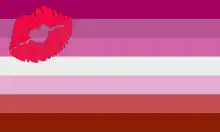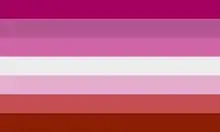"Lipstick lesbian" is slang for a lesbian who exhibits a greater amount of feminine gender attributes, such as wearing make-up, dresses or skirts, and having other characteristics associated with feminine women.[1] In popular usage, the term is also used to characterize the feminine gender expression of bisexual women,[1] or the broader topic of female–female sexual activity among feminine women.[2][3]
Definitions and society
The term lipstick lesbian was used in San Francisco at least as early as the 1980s. In 1982, Priscilla Rhoades, a journalist with the gay newspaper Sentinel, wrote the feature story "Lesbians for Lipstick".[6]
In 1990, the gay newspaper OutWeek covered the Lesbian Ladies Society, a Washington, D.C.–based social group of "feminine lesbians" that required women to wear a dress or skirt to its functions.[7]
The term lipstick lesbian became popular when used by writer Deborah Bergman, a reporter for the Los Angeles Times.[8]
Some authors have commented that lipstick lesbian is commonly used broadly to refer to feminine bisexual women or to heterosexual women who temporarily show romantic or sexual interest in other women to impress men. For example, Jodie Brian, in Encyclopedia of Gender and Society, Volume 1 (2009), states, "A common depiction of lipstick lesbianism includes conventionally attractive and sexually insatiable women who desire one another but only insofar as their desire is a performance for male onlookers or a precursor to sex with men."[2] In Intersectionality, Sexuality and Psychological Therapies (2012), lipstick lesbian is defined as "a lesbian/bisexual woman who exhibits 'feminine' attributes such as wearing makeup, dresses and high heeled shoes"; the book adds that "more recent iterations of feminine forms of lesbianism such as 'femme' (e.g. wears dresses/skirts or form-fitting jeans, low cut tops, makeup, jewelry), or 'lipstick lesbian' [...], are an attempt to define as both lesbian and feminine."[1]
Some lipstick lesbians say that they choose to perform femininity rather than be subjected to it, adding that they have made an active decision to be feminine, which subverts society's demand of forced femininity.[9][10][11] They commonly modify a typical feminine style to make it less heteronormative; Inge Blackman and Kathryn Perry gave the example of "twinning short skirts with Doctor Martens (DMs) or lacy underwear with men's trousers".[9]
Author M. Paz Galupo stated, "Young women exposed to mainstream media outlets are seeing expressions of the same-sex desire between women much more frequently than ever before. However, mainstream images of same-sex desire between women are very specific, meaning they are often of hyper-feminine women ('lipstick lesbians')."[3] The prominence of lipstick lesbians in the media is echoed by Rosalind Gill, who stated, "The figure of the 'luscious lesbian' [lipstick lesbian] within advertising is notable for her extraordinarily attractive, conventionally feminine appearance."[12] Although some authors have said that the existence of lipstick lesbians is a destabilization of heterosexual ideals, by breaking the assumption that a feminine person will always desire a masculine person, and vice versa, others have said that the lipstick lesbian emergence simply fails in this regard,[10][13] as lipstick lesbians are still subject to the male gaze, and still found acceptable due to their femininity.[10][14]
In media
The term is thought to have reached wide usage in the 1990s. A 1997 episode of the television show Ellen widely publicized the phrase. In the show, Ellen DeGeneres's character, asked by her parents whether a certain woman is a "dipstick lesbian", explains that the term is lipstick lesbian, and comments, "I would be a ChapStick lesbian." In the 1999 film But I'm a Cheerleader, the character played by Julie Delpy is identified as "Lipstick Lesbian" in the film credits.[15]
Flag controversy


The lipstick lesbian flag was introduced by Natalie McCray in 2010 in the weblog This Lesbian Life.[16][17] The design contains a red kiss in the left corner, superimposed on seven stripes consisting of six shades of red and pink colors and a white bar in the center.[18][19] However, it has not been widely adopted;[20] some lesbians have not adopted the flag because it is not inclusive of butch lesbians, while others have accused McCray of writing biphobic, racist, and transphobic comments on her blog.[21]
The colors of the "pink" lesbian flag were copied from the lipstick lesbian flag (with the kiss mark excluded).[19] The maker of the "pink" flag remains unknown. The pink flag attracted more use as a general lesbian pride flag.[22]
See also
References
- 1 2 3 das Nair, Roshan; Butler, Catherine, eds. (2012). "Gender, by Sonja J. Ellis". Intersectionality, Sexuality and Psychological Therapies: Working with Lesbian, Gay and Bisexual Diversity. BPS Blackwell. p. 49. ISBN 978-0470975008.
- 1 2 O'Brien, Jodi, ed. (2009). Encyclopedia of Gender and Society, Volume 1. SAGE Publications. pp. 491–493. ISBN 978-1560237020.
- 1 2 Galupo, M. Paz, ed. (2006). "Girl Friend or Girlfriend?: Same-Sex Friendship and Bisexual Images as a Context for Flexible Sexual Identity Among Young Women, by Elisabeth Morgan Thompson". Bisexual Women: Friendship and Social Organization. Haworth Press. p. 55. ISBN 978-1560237020.
- ↑ Keshia Kola (16 November 2007). "The Shesaurus: America's First Women's Dictionary-Thesaurus". Archived from the original on 6 February 2012. Retrieved 18 November 2007.
- ↑ "Issue 71" (PDF). G3 Magazine. April 2007. p. 10. Archived from the original (PDF) on 2 October 2008. Retrieved 19 November 2007.
- ↑ Stange, Mary Zeiss; Oyster, Carol K.; Sloan, Jane E., eds. (2011). "Sexualities: Lipstick Lesbians". The Multimedia Encyclopedia of Women in Today's World. SAGE Publications. pp. 549–551. ISBN 978-1412976855.
- ↑ Lynch, Patsy (4 April 1990). "Lesbian Ladies (or where did all the femmes go?)" (PDF). OutWeek. p. 44.
- ↑ Faderman, Lillian; Simmons, Stuart (2006). Gay L.A.: A History of Sexual Outlaws, Power Politics, and Lipstick Lesbians. New York. ISBN 978-0465022885.
{{cite book}}: CS1 maint: location missing publisher (link) - 1 2 Blackman, Inge; Perry, Kathryn (1990). "Skirting the Issue: Lesbian Fashion for the 1990s". Feminist Review (34): 67–78. doi:10.2307/1395306. JSTOR 1395306.
- 1 2 3 Bell, David; Binnie, Jon; Cream, Julia; Valentine, Gill (1994). "All hyped up and no place to go". Gender, Place & Culture. 1: 31–47. doi:10.1080/09663699408721199.
- ↑ Schorb, Jodi R.; Hammidi, Tania N. (2000). "Sho-Lo Showdown: The Do's and Don'ts of Lesbian Chic". Tulsa Studies in Women's Literature. 19 (2): 255. doi:10.2307/464429. JSTOR 464429.
- ↑ Gill, Rosalind (2009). "Beyond the 'Sexualization of Culture' Thesis: An Intersectional Analysis of 'Sixpacks', 'Midriffs' and 'Hot Lesbians' in Advertising". Sexualities. 12 (2): 137–160. doi:10.1177/1363460708100916. S2CID 144941660.
- ↑ Kirby, Andrew (1995). "VIEWPOINT Straight Talk on the Pomo Homo Question". Gender, Place & Culture. 2: 89–96. doi:10.1080/09663699550022125.
- ↑ Farquhar, Clare (2000). "'Lesbian' in a Post-Lesbian World? Policing Identity, Sex and Image". Sexualities. 3 (2): 219–236. doi:10.1177/136346000003002007. S2CID 56213569.
- ↑ Noh, David (September 2007). "But I'm a Cheerleader". Film Journal International. Archived from the original on 26 September 2007. Retrieved 17 February 2022.
- ↑ Mathers, Charlie (1 January 2018). "18 Pride flags you might not have seen before". Gay Star News. Archived from the original on 1 June 2021. Retrieved 4 June 2019. (The Mathers article shows the derivative design, but not the original flag.)
- ↑ Redwood, Soleil (26 February 2020). "A Horniman Lesbian Flag". Horniman Museum. Retrieved 21 November 2021.
- ↑ McCray, Natalie (July 2010). "LLFlag". This Lesbian Life. Archived from the original on 11 October 2016. Retrieved 9 June 2021.
- 1 2 Rawles, Timothy (12 July 2019). "The many flags of the LGBT community". San Diego Gay & Lesbian News. Archived from the original on 12 July 2019. Retrieved 3 September 2019.
- ↑ Bendix, Trish (8 September 2015). "Why don't lesbians have a pride flag of our own?". AfterEllen. Archived from the original on 9 September 2015. Retrieved 8 June 2019.
- ↑ Brabaw, Kasandra. "A Complete Guide To All The LGBTQ+ Flags & What They Mean". www.refinery29.com.
- ↑ Andersson, Jasmine (4 July 2019). "Pride flag guide: what the different flags look like, and what they all mean". i. Archived from the original on 24 August 2019. Retrieved 15 September 2021.
Further reading
- Butler, Judith (1990). Gender Trouble: Feminism and the Subversion of Identity. New York: Routledge. ISBN 978-0415900423.
- Hoskin, Rhea Ashley (December 2019). "Femmephobia: The Role of Anti-Femininity and Gender Policing in LGBTQ+ People's Experiences of Discrimination". Sex Roles. 81 (11–12): 686–703. doi:10.1007/s11199-019-01021-3. ISSN 0360-0025. S2CID 150965307.
- Mitchell, Bea (14 August 2017). "'Lipstick lesbian': 10 problems every femme lesbian will relate to". PinkNews.
- ""Lipstick Lesbian" Women Struggle With Prejudice". A Wider Bridge. 9 January 2017.